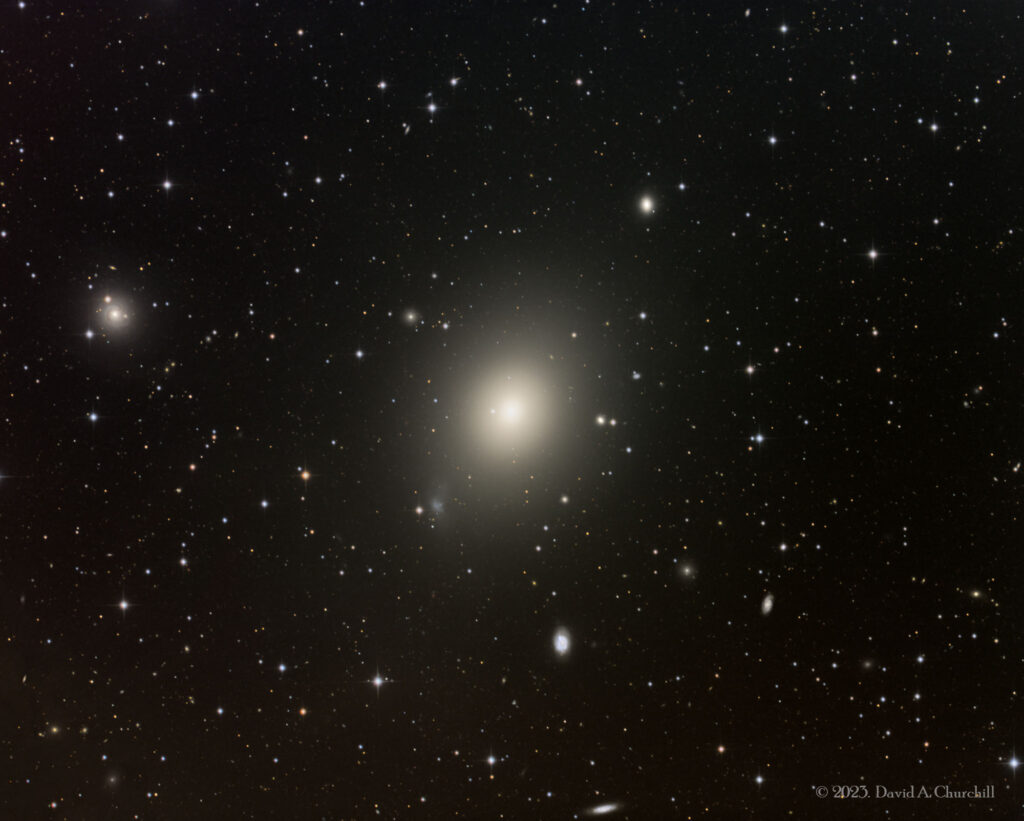Messier 49
Eliptical Galaxy, Virgo.
- Description
- Technical
- Links
Messier 49 (also known as M49 or NGC 4472) is a giant elliptical galaxy about 56 million light-years away in the equatorial constellation of Virgo. This galaxy was discovered by astronomer Charles Messier in 1777.
As an elliptical galaxy, Messier 49 has the physical form of a radio galaxy, but it only has the radio emission of a normal galaxy. From the detected radio emission, the core region has roughly 1053 erg (1046 J or 1022 YJ) of synchrotron energy. The nucleus of this galaxy is emitting X-rays, suggesting the likely presence of a supermassive black hole with an estimated mass of 5.65 × 108 solar masses, or 565 million times the mass of the Sun (M☉). X-ray emissions shows a structure to the north of Messier 49 that resembles a bow shock. To the southwest of the core, the luminous outline of the galaxy can be traced out to a distance of 260 kpc. The only supernova event seen within it is SN 1969Q, discovered in 1969.
This galaxy has many globular clusters: estimated to be about 5,900. This is far more than the roughly 200 orbiting the Milky Way, but dwarfed by the 13,450 orbiting the supergiant elliptical galaxy Messier 87. On average, the globular clusters of M49 are about 10 billion years old. Between 2000 and 2009, strong evidence for a stellar mass black hole was discovered in one. A second candidate was announced in 2011.
Messier 49 was the first member of the Virgo Cluster of galaxies to be discovered. It is the most luminous member of that cluster and more luminous than any galaxy closer to the Earth. This galaxy forms part of the smaller Virgo B subcluster 4.5° away from the dynamic center of the Virgo Cluster, centered on Messier 87. Messier 49 is gravitationally interacting with the dwarf irregular galaxy UGC 7636. The dwarf shows a trail of debris spanning roughly 1 × 5 arcminutes, which corresponds to a physical dimension of 6 × 30 kpc.
As an elliptical galaxy, Messier 49 has the physical form of a radio galaxy, but it only has the radio emission of a normal galaxy. From the detected radio emission, the core region has roughly 1053 erg (1046 J or 1022 YJ) of synchrotron energy. The nucleus of this galaxy is emitting X-rays, suggesting the likely presence of a supermassive black hole with an estimated mass of 5.65 × 108 solar masses, or 565 million times the mass of the Sun (M☉). X-ray emissions shows a structure to the north of Messier 49 that resembles a bow shock. To the southwest of the core, the luminous outline of the galaxy can be traced out to a distance of 260 kpc. The only supernova event seen within it is SN 1969Q, discovered in 1969.
This galaxy has many globular clusters: estimated to be about 5,900. This is far more than the roughly 200 orbiting the Milky Way, but dwarfed by the 13,450 orbiting the supergiant elliptical galaxy Messier 87. On average, the globular clusters of M49 are about 10 billion years old. Between 2000 and 2009, strong evidence for a stellar mass black hole was discovered in one. A second candidate was announced in 2011.
Messier 49 was the first member of the Virgo Cluster of galaxies to be discovered. It is the most luminous member of that cluster and more luminous than any galaxy closer to the Earth. This galaxy forms part of the smaller Virgo B subcluster 4.5° away from the dynamic center of the Virgo Cluster, centered on Messier 87. Messier 49 is gravitationally interacting with the dwarf irregular galaxy UGC 7636. The dwarf shows a trail of debris spanning roughly 1 × 5 arcminutes, which corresponds to a physical dimension of 6 × 30 kpc.
Telescope: Planewave CDK17 (FR) f4.5
Mount: Astro Physics 1600GTO
Camera: QHY16200A/ Integral FW
Guider: Agena Starguide II / ZWO ASI178MM
Filters: Astronomik 36mm LRGB
L: 51×10 mins = 510 mins, R: 24×10 mins = 240 mins, G: 24×10 mins = 240 mins, B: 24×10 mins = 240 mins
Total Imaging Time: 20h 30m
Data Imaged remotely over 6 nights during April 2023.
Imaged from Observatorio El Sauce, Chile, in partnership with Fred Espenak.
Data acquisition & Processing by David Churchill.
None

